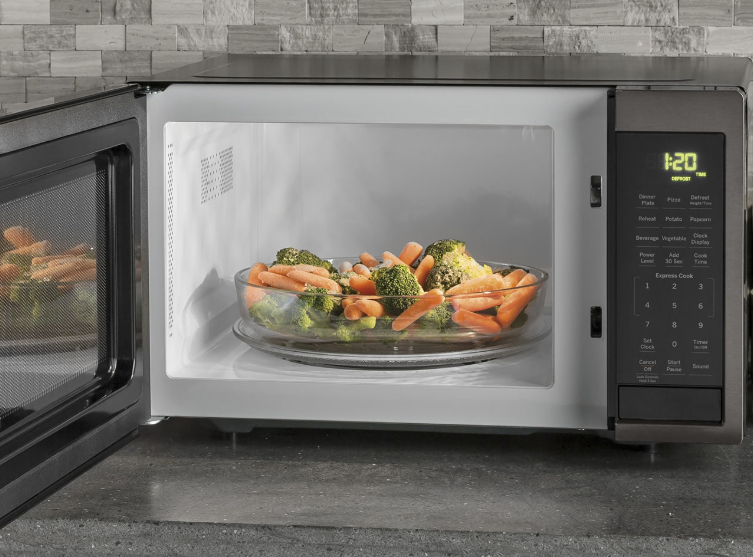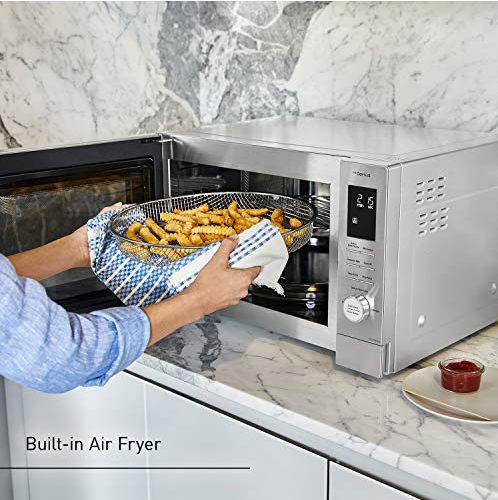Putting metal in the microwave is a common kitchen concern. It’s something many of us have been warned about since we were kids. But why is it such a big deal, and what exactly happens when you introduce metal objects to the electromagnetic waves inside your microwave oven? This article will explore the science behind this kitchen conundrum and provide clear guidelines on what you can and absolutely cannot put inside your microwave.
The Science Behind Why Metal Sparks in a Microwave
Microwaves heat food by exciting water molecules. Metal, however, interacts differently with these waves. Instead of absorbing the energy and converting it to heat, metal reflects microwaves. This reflection can create standing waves – areas of concentrated electromagnetic energy – inside the oven. These concentrated waves can build up to extremely high voltages, causing sparks to jump between the metal object and other metallic parts of the microwave, like the interior walls.
What Happens When Metal is Microwaved?
- Sparking: The most common and immediate effect is sparking. This isn’t just a visual spectacle; it’s a sign of potentially dangerous electrical discharges.
- Fire Hazard: If the metal is thin or has sharp edges, the sparks can ignite nearby flammable materials like paper towels or food packaging.
- Damage to the Microwave: Repeated sparking can damage the magnetron, the component responsible for generating microwaves, potentially rendering your oven unusable.
- Uneven Heating: While thicker pieces of metal may not spark as dramatically, they can still reflect microwaves, leading to uneven heating of your food.

A dangerous scene of metal sparking brightly inside a running microwave oven, illustrating a kitchen fire hazard.
What Types of Metal are Especially Dangerous?
Some types of metal pose a greater risk than others:
- Thin, crumpled foil: This presents a large surface area for sparks to jump between.
- Sharp edges: Points and edges concentrate electrical fields, making sparking more likely.
- Twisted ties: The thin wire can quickly overheat and become a fire hazard.
- Metal cookware: Pots and pans are generally not microwave-safe and can block microwaves, preventing your food from heating properly.
Are There Any Exceptions to the “No Metal” Rule?
While the general rule is to avoid putting metal in the microwave, there are a few exceptions. Some microwave-safe dishes incorporate small amounts of metal, like in the rim or decorative elements. These are designed specifically for microwave use and are tested to ensure safety. Look for the “microwave-safe” label on the packaging.
Can You Microwave Food with Aluminum Foil?
While generally advised against, using small, smooth pieces of aluminum foil to shield specific areas of food from overcooking is sometimes acceptable. However, this should be done cautiously and with the foil placed flat and away from the oven walls.
“Using aluminum foil in the microwave is like walking a tightrope,” says kitchen safety expert, Dr. Amelia Carter, “It can be done, but it requires careful attention and understanding of the risks involved. One wrong move and you could end up with a fire.”
What to Do If You Accidentally Put Metal in the Microwave
If you accidentally put metal in the microwave and see sparks, immediately turn off the oven and unplug it from the power source. Do not open the door until the sparking has completely stopped. Once safe, carefully remove the metal object. If you notice any damage to the microwave or smell burning, consult a professional before using it again.
Myths About Microwaving Metal
- Myth: All metal will explode in the microwave. While dramatic, this is an exaggeration. Sparking is more likely, but explosions are rare.
- Myth: Microwaving metal will always damage the oven. Occasional, brief sparking might not cause permanent damage, but repeated incidents can certainly shorten its lifespan.
“The biggest misconception is that a tiny piece of metal is harmless,” states microwave engineer, Mr. David Chen. “Even a small twist tie can create enough sparking to ignite a fire. It’s always better to err on the side of caution and keep all metal out of the microwave.”

A comparison image showing unsafe metal items like foil and forks next to microwave-safe containers.
Conclusion
Understanding the interaction between metal and microwaves is crucial for kitchen safety. While the general rule is to avoid putting metal in the microwave, a few exceptions exist. Always prioritize safety, be mindful of the potential risks, and follow manufacturer guidelines to ensure your microwave remains a safe and effective cooking tool. Can you put metal in a Microwave Oven? The answer is generally no, unless specifically designed for microwave use.
Frequently Asked Questions
- Can I microwave food on a metal plate? No, metal plates will reflect microwaves and prevent your food from heating properly.
- Is it safe to microwave food with a metal fork or spoon? No, metal cutlery can cause sparking and potentially damage your microwave.
- What about metal decorations on dishes? If the dish is labeled as microwave-safe, the metallic decoration is likely designed for microwave use. However, if you’re unsure, it’s best to err on the side of caution.
- Can I use aluminum foil to cover food in the microwave? While generally discouraged, using small, smooth pieces of foil to shield specific food areas is sometimes acceptable. Be cautious and ensure the foil is flat and away from the oven walls.
- My microwave sparked when I heated something with a small metal piece. Is it broken? Occasional sparking might not cause permanent damage, but if you notice any unusual behavior or smell burning, it’s best to have it checked by a professional.
- What should I do if my microwave catches fire? Immediately unplug the microwave and call emergency services. Do not attempt to extinguish the fire yourself.
- Are there any metal containers specifically designed for microwaves? Yes, some specialized browning dishes utilize metal components to achieve crispier results. These are specifically designed and tested for microwave use. Always check for the “microwave-safe” label.